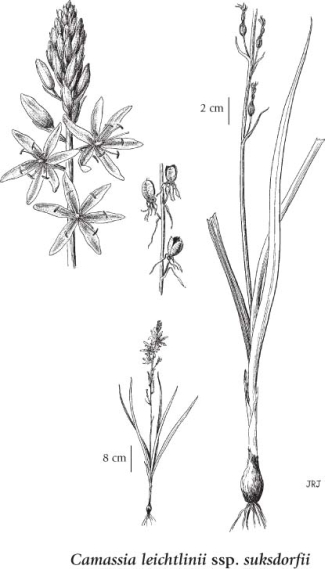great camas (Suksdorf's large camas)
Asparagaceae
(Previously in Liliaceae)
Introduction to Vascular Plants
Map
Distribution of Camassia leichtlinii subsp. suksdorfii
Click here to view the full interactive map and legend
Introduction
Elegant spires covered with masses of star-shaped purple-blue flowers with glittering yellow anthers. This is a larger species than C. quamash. Native from BC to southern California.
Meadows, prairies and hillsides that are moist, at least in early spring. Note Author: Gary Lewis, Phoenix Perennials |
Species Information
General:
Perennial herb from a deep, egg-shaped bulb 2-4 cm long; flowering stems 20-100 cm tall, smooth.
Leaves:
Basal leaves several to numerous, linear-lanceolate and grass-like, to 60 cm long, 1-2 cm wide, smooth, sheathing at the base, the margins entire; stem leaves lacking.
Flowers:
Inflorescence a terminal raceme of 5 to many, stalked flowers, the stalks 1-4 cm long, spreading in flower, spreading to ascending in fruit; flowers pale to deep blue, rarely white, of 6 similar, distinct tepals, the tepals 20-40 mm long, 5-10 mm wide, twisting together over the ovaries when withered; stamens 6; pistil 1, 3-chambered.
Fruits:
Capsules, egg-shaped to oblong, cross-ridged, 1-2.5 cm long; fruiting stalks often longer than bracts, spreading to ascending, curved in towards stem; seeds several to many, shiny black, 2-4 mm long.
Illustration

If more than one illustration is available for a species (e.g., separate illustrations were provided for two subspecies) then links to the separate images will be provided below. Note that individual subspecies or varietal illustrations are not always available.
Illustration Source: The Illustrated Flora of British Columbia
Habitat and Range
Vernally moist meadows in the lowland zone; locally frequent on SE Vancouver Island and the Gulf Islands, one report also from adjacent mainland (Sechelt Peninsula); S to CA.Status Information
Synonyms
Synonyms and Alternate Names:
Camassia leichtlinii
Camassia leichtlinii var. suksdorfii (Greenm.) C.L. Hitchc.
Camassia suksdorfii Greenm.
Taxonomic Keys
KEY TO CAMASSIA
1. Tepals (petal-like segments) twisted together around ovaries after flower wither; flowers more or less radially symmetric; fruiting stalks longer than the bracts........................ C. leichtlinii subsp. suksdorfii 1. Tepals spreading apart, not twisted together around ovaries after flowers wither; flowers weakly bilaterally symmetric; with 5 tepals curving upward and 1 pointing downward; fruiting stalks shorter than the bracts.....................C. quamash |
